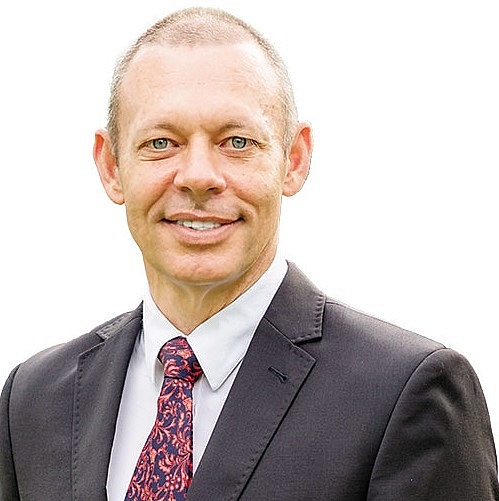Racing toward the future of Vietnam
On the occasion of the Lunar New Year, VIR spoke to several foreign managers who have worked in Vietnam for years to get their take on the economy’s development, the challenges of their business sectors, and what successes coming to Vietnam has brought for their companies.
Gavin Herholdt Managing Director, Laguna Lang Co
 |
| Gavin Herholdt |
The transformation of the Vietnamese economy is stunning and widely reported as eclipsing other major Southeast Asian markets with a long-term average GDP growth rate of 6.19 per cent achieved from 2000 to 2016. Even more extraordinary is the growth achieved in central Vietnam specifically. While the north and south of the country are still the capitals of industry and enterprise, the 2017 growth rates in Quang Nam, Danang, and Hue of 5.1 per cent (2016 was the highest in the last decade at 14.7 per cent), 8.1 per cent, and 7.1 per cent year-on-year, respectively, are unheard of in other parts of the world.
These growth rates have delivered tangible change in these provinces – new developments and substantial infrastructure upgrades are being delivered in short time frames and, even more impressively, on schedule. Skylines of the major centres are being transformed, and the increased vitality of the local communities is plainly evident with businesses operating in a “can do” frame of mind.
Of course, the scene is set by government at all levels. In many countries, private industry wishes to progress quickly and the government institutions need to be dragged along. In Vietnam, it feels different, as it is the government ministries and departments demanding rapid investment and development.
In central Vietnam, tourism is considered to be a key industry that is able to drive this transformative change and it is an industry which I am engaged in and familiar with. It is refreshing to work in an industry that the government holds as a high priority, and the tail wind for quick expansion is stronger in Vietnam than anywhere I have ever experienced. The goals of government and private enterprise are completely aligned and all parties are charging ahead.
Maintaining strong growth for prolonged periods is difficult and requires anticipation of the challenges that lie ahead. Very significant building blocks need to be put in place. Training local communities to have a very wide range of skills in sufficient numbers to supply visitation growth rates of circa 30 per cent per annum, for example, does not happen without foresight and commitment.
Our business operates in a five-star environment with 90 per cent of our guests being foreigners from all corners of the globe. The only common language is English and we need to ensure our workforce has adequate English language proficiency before specific task-based and management skills are learned. We work closely with colleges and training institutions in our local area to generate our own workforce. And the results are stunning; training programmes we offer are transforming young staff with few language and no hospitality skills to professionals operating in a five-star environment within 12 months.
The rate of development and growth in the economy has made the youth of Vietnam ambitious, and they have proved to be fast learners. I believe that the policy of the government to use foreign direct investment to drive growth is the key to the rapid increase in the capability of the Vietnamese workforce. It allows all the lessons learnt in countries over the last 20 to 30 years to be injected into the local economy in a short period of time. Leapfrogging old technologies also helps, and the penetration rates of mobile and internet throughout the population is both surprising and helpful to increasing the rate of development.
Our bond with local communities is strong and I believe that they are proud of the way in which we are developing our integrated resort. At Laguna Lang Co, we have 1,050 full time staff, with only 25 being foreigners, most of them Southeast Asia. This is due to the fact that our developer, Banyan Tree, opened its first resort in Thailand 24 years ago and has since provided opportunities for its staff to transfer between their properties across approximately 30 countries to gain international experience.
We are typical of many businesses operating in central Vietnam. We have strong support from the national and provincial (Thua Thien-Hue) governments and benefit from the new international terminal at Danang International Airport, which last year increased international visitor arrivals by 37 per cent year-on-year. Combined with the natural beauty of our surroundings operating in one of the most beautiful bays in the world, the plethora of UNESCO world heritage sites at our doorstep, and the resurgence of tourist attractions in the historic imperial city of Hue, it makes sense for us to expand our business over the next few years, and we are set to do so in 2018.
We are encouraged by the growing reputation of our 18-hole golf course designed by Sir Nick Faldo, a six-time Major championship winner. As two five-star Banyan Tree hotels in our resort are just a short walk from the golf course, we have been named the Best Golf Resort in Vietnam by Golf Digest. This is a well-deserved accolade that we hold proudly, driving us to attain higher levels of hospitality that show the rest of the world that Vietnam is not only developing quickly, but becoming a leader to other countries.
Aymar De Liedekerke Beaufort Head of Country for Vietnam, BNP Paribas
 |
| Aymar De Liedekerke Beaufort |
The year 2017 was a very positive year for BNP Paribas Vietnam, thanks to the favourable economic conditions in the country. Full-year GDP growth was higher than expected at 6.8 per cent. Our international and local clients benefited from this growth and we were able to assist them in their ambitions across the board with our corporate banking, advisory and strategic financing, and investment solutions. Indeed, this positive growth trend should continue in 2018 and 2019, with a projected average annual GDP growth of 6.4 per cent.
Foreign direct investment has increased steadily, reflecting a continued strong investor interest due to the country’s large market potential with its population of 93 million and its attractive manpower and manufacturing conditions, both in terms of cost and quality, as well as its positive GDP trend. This is good news for BNP Paribas in Vietnam. As a leading international bank with a strong global network – especially in our home markets in Europe – we are in a unique position to help multinational corporations (MNCs) and strategic investors with their needs. This gives us the opportunity to deepen our relationship with these clients across diverse sectors such as commodities, fast-moving consumer goods, and new technologies.
Credit growth is something we carefully look at. BNP Paribas Vietnam’s credit growth mirrored Vietnam’s significant 18 per cent credit growth in 2017. The needs of our clients, both local companies and MNCs, grew substantially, peaking in the last months of the year. In this growing and competitive market, our focus is to partner with our clients for their needs around financing, trade activity, liquidity management, as well as risk management. With markets remaining strong and companies looking at raising funds, we can offer solutions for companies to raise capital. Last year, BNP Paribas Vietnam successfully supported VietJet in its initial public offering and we intend to replicate this with other Vietnamese corporations in the future.
Vietnamese exports and imports increased by around 20 per cent in 2017 and BNP Paribas Vietnam was able to capture part of this value, thanks to innovative financial products relevant to our clients’ needs. For example, successful implementation of several supply chain financing programmes allowed us to support the growth of Vietnamese corporations by meeting their individual and unique requirements for improving business efficiency. These programmes demonstrate BNP Paribas Vietnam’s ability to adapt its products to the specificities of the Vietnamese market.
Vietnam will further diversify its economic partners in 2018 and deepen its integration into international trade (ASEAN, Regional Comprehensive Economic Partnership, and the EU-Vietnam Free Trade Agreement). BNP Paribas is looking closely at new potential business opportunities across existing relationships, thanks to its wide network in Asia Pacific and in the world.
Particularly on the EU-Vietnam Free Trade Agreement, considerable efforts have already been made between Vietnam and the EU, and the ratification of the agreement in 2018 is a very important development for both economies. As a leading bank for corporations in Europe, BNP Paribas is well-positioned to partner with our clients in making the most of this positive momentum. Again, our network strength in Europe and also within the Asia Pacific region continues to be an important enabler of cross-border investment. With Vietnam opening up foreign investment in various sectors, we facilitate European companies looking to invest into the market, as well as Vietnamese companies looking to spread their wings across borders. It is also critical that our clients capture this trade and capital flow, and we enable this by supporting their cross-border cash management and trade financing needs.
BNP Paribas Vietnam will continue to partner with Vietnamese corporations into 2018, when business regulations should continue to ease. Indeed, the government will continue to liberalise the economy step by step while restructuring state-owned enterprises (SOE). We look forward to supporting our existing and potential SOE clients to navigate challenges and maximise opportunities in 2018.
In the years to come, Vietnam with its growth potential represents a key market for BNP Paribas in the Asia Pacific region, which will continue to be a growth region for the bank.
Josephine Yei CEO, SaigonBank Berjaya Securities Company
 |
| Josephine Yei |
Following the highs of last year’s third quarter, the VN-Index – a capitalisation-weighted index of all companies listed on the Ho Chi Minh City Stock Exchange – surpassed 1,000 points on January 3 for the first time in a decade, since before the global financial crisis in 2007. This came as a further confidence boost to many investors, both local and international. Foreign investors made more than $1 billion of net purchases last year, the highest amount in five years, and they are expected to stick around for the further privatisation of public firms.
Foreign direct investment inflow in 2017 also fared well by reaching $35.88 billion, up 44 per cent against 2016 and another 10-year high, according to the Ministry of Planning and Investment.
The stock market will reflect the conditions of an economy. If an economy is growing, then output will increase and most companies should experience increased profitability. This raised profit makes the company shares more attractive – because they can give bigger dividends to shareholders. If a country has a consistently higher rate of economic growth, then, generally speaking, stock markets will perform better than in a country with lower rates of growth. The link may not be perfect but there is some correlation.
When I first transferred to Vietnam in June 2008, I saw the stock market retreating following the effects of the global financial crisis, with the VN-Index hovering between 400 to 600 points until the first quarter of 2016. Since then, the stock market has been growing gradually and just surpassed 1000 points in January. Here we can see the correlation between economic growth and stock market performance.
Vietnam has performed well over the last 10 years, though the road to recovery was bumpy. Moving forward, Vietnam still has room for growth in both the economy and stock market performance. It is not easy to surpass the outstanding economic growth and stock market performance of 2017. Learning from other neighbouring countries and coupled with past experience, the authorities have shown their dedication to improving the current performance. The sustainability and continuous growth is not only the government’s effort, but indeed all sectors’, and including each individual. We can see this from the U23 football team’s recent display of a strong fighting spirit and the support they received from across the nation. It does take effort and time to grow if one has plans to achieve a goal. Similarly, it is time for Vietnam to think clearly about what it is they want to achieve in the future.
It is worth putting consideration into the imagination and building of our future economy. We have no idea what a low-carbon economy will actually look like. To date, we have only seen industrial economies from other advanced countries. It will probably be some time before an appropriate strategy is developed and tested in practice but, at a minimum, it should acknowledge that the basis for future growth starts now. It starts today. We must not be complacent with our achievements so far. There is reason for hope as the future economy offers us an opportunity to think about where we want to go and what it will take to get there.
Hence, both the government and private sectors should be in constant communication to understand each other, collaborating to synergise business growth and thus the economy. We can’t expect foreign investment to always stay focused on Vietnam, as other countries are also moving to attract these resources. It is from organic growth – internally blended with technology, exchange of knowledge and experience, and data – that we can further enhance the growth of business.
It is important to create opportunities, and not just wait for one to present itself, as there is always someone ahead. Vietnam, with its large, dynamic, and youthful population, should create opportunities to help one another become a strong nation in the competitive years to come. The future economy starts from what we do today. Therefore, reformation is needed – and it is not something to be scared of. Reform for a good cause, to build a better economy, and for the benefit of its people are good reasons for change. The vitality of Vietnam’s economy lies in everyone’s hands across the country. It will not be a surprise when one day, Vietnam can be an important foreign investor to other countries. We need hope to achieve our dreams.
Wishing you all a good year ahead and that Vietnam can achieve new heights. May your dreams come true, Vietnam!
What the stars mean:
★ Poor ★ ★ Promising ★★★ Good ★★★★ Very good ★★★★★ Exceptional
Latest News
More News
- Human-centred governance seen as key to AI development (December 19, 2025 | 18:19)
- Top 10 notable events of Vietnam’s industry and trade sector in 2025 (December 19, 2025 | 14:00)
- Tungsten surges to 12-year high as world enters a new 'black gold' race (December 18, 2025 | 17:27)
- Vietnam’s coffee exports set new record despite price pressures (December 18, 2025 | 17:13)
- Garment and textile sector seeks new growth after volatile year (December 18, 2025 | 17:01)
- VinSpeed and Siemens strengthen cooperation for high-speed rail development (December 18, 2025 | 16:53)
- High-tech adoption for TH true MILK (December 18, 2025 | 13:39)
- Takeda supports health resilience amid climate change challenges (December 18, 2025 | 12:39)
- Mondelez Kinh Do - a chapter of purpose-led leadership in Vietnam (December 18, 2025 | 09:44)
- VNPAY services receive the highest-level PCI DSS international security certificates for six consecutive years (December 17, 2025 | 23:47)

 Tag:
Tag:















 Mobile Version
Mobile Version